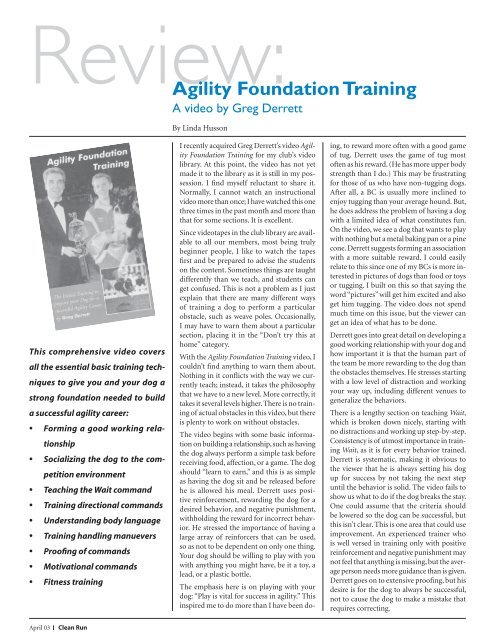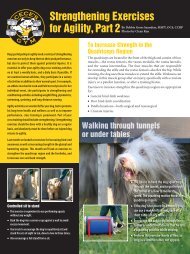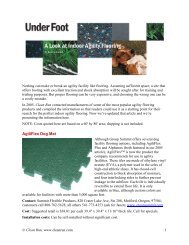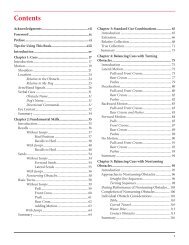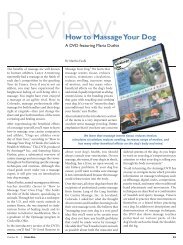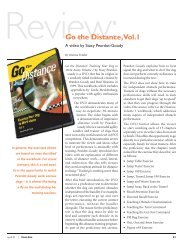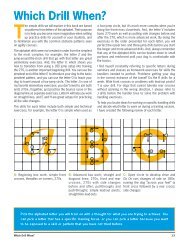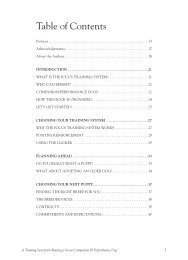Review - Clean Run
Review - Clean Run
Review - Clean Run
Create successful ePaper yourself
Turn your PDF publications into a flip-book with our unique Google optimized e-Paper software.
<strong>Review</strong>:Agility Foundation TrainingA video by Greg DerrettBy Linda HussonThis comprehensive video coversall the essential basic training techniquesto give you and your dog astrong foundation needed to builda successful agility career:• Forming a good working relationship• Socializing the dog to the competitionenvironment• Teaching the Wait command• Training directional commands• Understanding body language• Training handling manuevers• Proofing of commands• Motivational commands• Fitness trainingI recently acquired Greg Derrett’s video AgilityFoundation Training for my club’s videolibrary. At this point, the video has not yetmade it to the library as it is still in my possession.I find myself reluctant to share it.Normally, I cannot watch an instructionalvideo more than once; I have watched this onethree times in the past month and more thanthat for some sections. It is excellent.Since videotapes in the club library are availableto all our members, most being trulybeginner people, I like to watch the tapesfirst and be prepared to advise the studentson the content. Sometimes things are taughtdifferently than we teach, and students canget confused. This is not a problem as I justexplain that there are many different waysof training a dog to perform a particularobstacle, such as weave poles. Occasionally,I may have to warn them about a particularsection, placing it in the “Don’t try this athome” category.With the Agility Foundation Training video, Icouldn’t find anything to warn them about.Nothing in it conflicts with the way we currentlyteach; instead, it takes the philosophythat we have to a new level. More correctly, ittakes it several levels higher. There is no trainingof actual obstacles in this video, but thereis plenty to work on without obstacles.The video begins with some basic informationon building a relationship, such as havingthe dog always perform a simple task beforereceiving food, affection, or a game. The dogshould “learn to earn,” and this is as simpleas having the dog sit and be released beforehe is allowed his meal. Derrett uses positivereinforcement, rewarding the dog for adesired behavior, and negative punishment,withholding the reward for incorrect behavior.He stressed the importance of having alarge array of reinforcers that can be used,so as not to be dependent on only one thing.Your dog should be willing to play with youwith anything you might have, be it a toy, alead, or a plastic bottle.The emphasis here is on playing with yourdog: “Play is vital for success in agility.” Thisinspired me to do more than I have been doing,to reward more often with a good gameof tug. Derrett uses the game of tug mostoften as his reward. (He has more upper bodystrength than I do.) This may be frustratingfor those of us who have non-tugging dogs.After all, a BC is usually more inclined toenjoy tugging than your average hound. But,he does address the problem of having a dogwith a limited idea of what constitutes fun.On the video, we see a dog that wants to playwith nothing but a metal baking pan or a pinecone. Derrett suggests forming an associationwith a more suitable reward. I could easilyrelate to this since one of my BCs is more interestedin pictures of dogs than food or toysor tugging. I built on this so that saying theword “pictures” will get him excited and alsoget him tugging. The video does not spendmuch time on this issue, but the viewer canget an idea of what has to be done.Derrett goes into great detail on developing agood working relationship with your dog andhow important it is that the human part ofthe team be more rewarding to the dog thanthe obstacles themselves. He stresses startingwith a low level of distraction and workingyour way up, including different venues togeneralize the behaviors.There is a lengthy section on teaching Wait,which is broken down nicely, starting withno distractions and working up step-by-step.Consistency is of utmost importance in trainingWait, as it is for every behavior trained.Derrett is systematic, making it obvious tothe viewer that he is always setting his dogup for success by not taking the next stepuntil the behavior is solid. The video fails toshow us what to do if the dog breaks the stay.One could assume that the criteria shouldbe lowered so the dog can be successful, butthis isn’t clear. This is one area that could useimprovement. An experienced trainer whois well versed in training only with positivereinforcement and negative punishment maynot feel that anything is missing, but the averageperson needs more guidance than is given.Derrett goes on to extensive proofing, but hisdesire is for the dog to always be successful,not to cause the dog to make a mistake thatrequires correcting.April 03<strong>Clean</strong> <strong>Run</strong>
The next segment is on teaching the dog Leftand Right, which is taught before the dogever sees equipment. Again, this is presentedin a systematic, step-by-step method. WhileDerrett’s method may be difficult if your dogis not a big tugger, the general idea can stillbe followed. He does demonstrate with jumpboxes how these cues are put into practice,where the dog has learned the verbal to suchan extent that body position is irrelevant tothe dog. The proofing phase is pretty amazing,seeing the dog perform a 270 in a doublejump box with verbal cues only. While Derrettconcedes that these commands are notnecessary if you are never at a distance fromyour dog, or if you are not comfortable usingthem, they can still be fun to teach.The section on Understanding Body Languageis based on what Derrett calls “circlework.” This involves quite a bit of runningon the handler’s part, so it may not be apopular exercise. However, even those of uswho are not marathon runners can benefitfrom doing this, if only in small increments.This provides the foundation needed to buildup to teaching the body language for a frontcross and a rear cross. I like how he teachesthe dog the body language for a rear cross.It’s something I can have a student work onwithout any equipment, keeping it fun for thedog while the dog is learning to turn awayfrom the handler.I enjoyed the part on motivational commands,as these can be useful for every dog.You can get the lower-drive dogs jazzed up,and the high-drive dogs learn control withoutsacrificing attitude. Extending the use of thesecommands to encourage acceleration off thestart line, and driving over the last jump for afast finish, are not totally new concepts to me,but a reminder of how important they are.Also included are brief segments on fitnesstraining for the dog and trick training. Theidea of fitness for the dog is often overlooked,and I think it’s especially important forbeginners to be made aware of the physicaldemands of the sport of agility. Trick trainingshould also not be overlooked. According toDerrett, this is a good way to find out howyour particular dog learns. I was pleased tosee that he advocates clicker training.The whole video drives home the importanceof good, strong foundation skills, as well as astrong reinforcement history and the abilityto be able to reward the dog in a multitude ofways. All the segments were progressive, andDerrett’s presentation of each step was clear.In addition to the content, the quality of thetape, both video and audio, was excellent.The “out-takes” at the end are a great wayto finish off the tape, letting us see that noone is perfect. It allows us to see that Derrettis human and even his wonderful dogs arestill dogs.I think this video is useful to all levels of agilityenthusiasts. Those of us who have beeninvolved in dog training and/or agility forseveral years are probably able to get moreout of the video than a beginner, simplybecause of experience and how we can seeholes in our foundation with our multipleagility dogs (different dogs, different holes).The video reminded me of how important thegroundwork is and gave me new ideas as wellas inspiration to stick with it. I think the tapeis applicable to novices who want to competeand do their best. For the beginners who justwant to “play with the equipment,” it could bea real eye-opener. I would not expect them tofollow the program outlined in the video. But,if they could do just a small fraction of whatDerrett proposes, there would be a markedimprovement in their relationships and communicationskills with their dogs.This is one of the most worthwhile investmentsan agility enthusiast can make. I hadmy club purchase it for the library, as I wasreluctant to buy it myself before viewing it...but I think I will have to buy my own copysince the whole idea was to make it accessibleto the students. For the record, I have neverseen Greg Derrett, met him, or talked withhim. All I know of him is what I saw on thevideo. I eagerly await his next video and willbuy it without a moment’s hesitation!Linda Husson has been involved in dogtraining for 16 years, beginning withcompetition obedience. She startedcompeting in agility 10 years ago, with anOTCH Sheltie who eventually acquired hisMAD, JM, and MX. She currently lives withthree Border Collies; two have earned theirADCH, MX, and MXJ, and the youngest isworking on his Masters titles. Linda livesin Pennsylvania and may be contacted atbarkingadchoo@yahoo.com.70 <strong>Clean</strong> <strong>Run</strong> April 03


